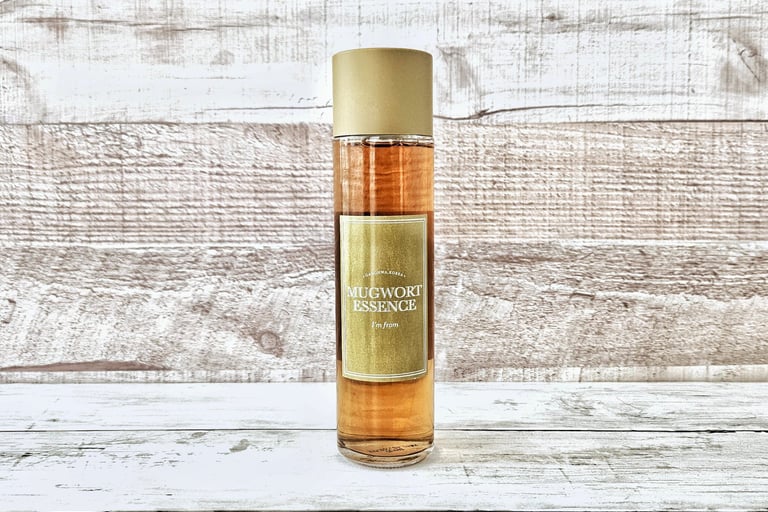Why You Should Be Using Mugwort On Your Skin
Learn how Mugwort can calm skin redness, irritation, and breakouts.
SKINCARE


Disclosure: This post contains affiliate links, which means I may earn a small commission at no extra cost to you. I only share products I personally use and love.
When I first heard about mugwort in skincare, I thought: “Okay, this is new, maybe a trend.” But after adding a mugwort essence into my skincare routine, noticing how my skin softened, how those odd red patches on my cheeks dulled, I realized this herb isn’t just hype. It’s quietly effective.
Here’s the thing, skin irritation, redness, that tight-scratchy feeling you get after a long flight or a bad breakout, they all show up like little alarms in your skin’s system. For me, mugwort changed that alarm into a whisper.
Let’s look at what mugwort is, why I’m using it, how it benefits skin, and how you can incorporate it so you can judge for yourself.
What Is Mugwort (and Why It’s So Popular in Korean Skincare)
Mugwort (also known as Artemisia vulgaris or Artemisia princeps) is a leafy green herb that’s been used for centuries in traditional medicine, especially across East Asia. It was once brewed in teas or used in healing rituals to calm the body and clear inflammation. In recent years, though, this ancient herb has found a modern home in Korean skincare.
If you’ve ever explored K-beauty, you know the emphasis is on gentle, soothing ingredients that strengthen the skin barrier instead of stripping it. Mugwort fits right in. Its naturally calming, anti-inflammatory properties make it a favorite in toners, essences, and sheet masks designed for sensitive or redness-prone skin. Korean beauty brands like I’m From, Round Lab, and Isntree helped make it a cult ingredient, especially for people who wanted something that could reduce irritation without compromising the skin’s moisture barrier.
Mugwort is like a reset button for overworked skin. The plant is rich in:
Flavonoids and antioxidants that help defend against environmental stressors.
Anti-inflammatory compounds that calm redness and irritation.
Natural oils and polysaccharides that support hydration and barrier repair.
The Skin Benefits of Mugwort Toner/Essence
Anti-Inflammatory & Calming Action
Redness, stinging, irritation are the skin’s way of raising its hand. Mugwort interacts with those signals—bioactive compounds that help soothe the skin’s alarm system. When your skin isn’t buzzing, it can recover. It can absorb treatments, it can hold moisture, it can rebuild.
Redness & Sensitive Skin Relief
If your skin reacts to weather, heat, treatments or fluctuating hormones, mugwort helps. It’s used in K-beauty often for sensitive complexions. One piece I read noted that mugwort shows promise for skin conditions like eczema, acne or psoriasis (though with caution: more research is still needed).
Barrier & Moisture Support
A healthy skin barrier means less water loss, less irritation from external factors, and a calmer appearance. Mugwort’s antioxidants and plant oils help reinforce that.
Antioxidant & Environmental Defense
Your skin fights pollution, stress, and UV daily. Mugwort brings antioxidants into the mix: vitamin E, plant phenols, and the like. These help protect against oxidative stress.
Acne/Breakout Support (Especially for Redness-Driven Blemishes)
While it’s not a replacement for acne medications, mugwort has antibacterial + soothing properties. That means less inflammation around a breakout = faster recovery.
How to Use a Mugwort Toner/Essence
Here’s how I layer mine. These steps help you get more from the product rather than just “add it and forget it”.
Cleanse gently: Start with a low-irritant cleanser so you’re not inflaming the skin further. I recommend double cleansing first.
Toner/Essence time: After cleansing, apply the mugwort toner or essence. I pour directly into my palm and pat it onto my skin, especially focusing on any red/hot zones.
Follow with hydrators and barrier support: Use a lightweight serum (if you use one) and finish with a moisturizer suited to your skin type.
Consistency is key: I found the real benefit after 3-4 weeks of steady use.
Don't forget to patch test: Especially if you have sensitive or highly reactive skin. Mugwort is gentle for many, but it’s still a botanical and can cause reaction in some.
I love the I'm From Mugwort Essence. It glides on so smoothly!
What to Expect (And What Not to Expect)
Realistic benefits: Softer skin, calmer redness, fewer “raw” days, stronger barrier.
Not a miracle fix: If you have severe eczema or psoriasis, mugwort alone won’t replace medical treatments. The research, while promising, is still early.
Possible sensitivity: Some people may experience irritation (particularly if they’re allergic to ragweed/mugwort family). Always patch test.
Best as part of a routine, not a standalone fix: Cleanse, protect (SPF daily), hydrate, treat, sleep well.
Final Thoughts
So if your skin feels like it’s too red, too hot, or too reactive, bringing in a mugwort toner or essence might give it the calm it’s asking for. It’s part of a slower, gentler approach rather than the “fix everything in one night” mindset.
As an Amazon Associate, I earn from qualifying purchases.


